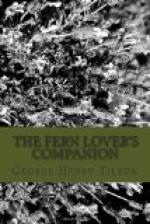[Illustration: Hayscented Fern. Dennstaedtia punctilobula (Sudbury, Mass. G.E.D.)]
[Illustration: Forked Variety of Hayscented Fern]
[Illustration: Hayscented Fern. Dennstaedtia punctilobula]
While Dennstaedtia is the approved scientific name of this species, the name Dicksonia has come to be used almost as commonly as hay scented fern or boulder fern. It is one of our most graceful and delicate species, its long-tapering outline suggesting the bulblet bladder fern. It delights to cluster around rocks and boulders in upland fields and pastures and in the margin of rocky woods. It is sweet-scented in drying. A fine species for the fernery and one of the most decorative of the entire fern family. The effect of the shimmering fronds, so delicately wrought, flanked by evergreens, is highly artistic. Fine-haired mountain fern, pasture fern, and hairy Dicksonia are other names. Canada to Tennessee and westward.
Var. cristata has the fronds more or less forked at the top.
[Illustration: Pinnule and Sori]
[Illustration: Mass of Sensitive Fern]
THE SENSITIVE AND OSTRICH FERNS
Onoclea. PTERETIS. Matteuccia. Struthiopteris
(Last three names applied to Ostrich Fern only.)
It is a question whether the sensitive and ostrich fern should be included in the same genus. They are similar in many respects, but not in all. The sensitive fern has a running rootstock, scattered fronds, and netted veins; while the ostrich fern has an upright rootstock, fronds in crowns, and free veins.
[Illustration: Sensitive Fern. Gradations from Leaf to Fruit. Obtusilobata Form]
(1) SENSITIVE FERN. Onoclea sensibilis
Fronds one to three feet high, scattered along a creeping rootstock, broadly triangular, deeply pinnatifid, with segments sinuately lobed or nearly entire. Veins reticulated with fine meshes. The fertile fronds shorter, closely bipinnate with the pinnules rolled up into berry-like structures which contain the spore cases. (The name in Greek means a closed vessel, in allusion to the berry-like fertile segments.) The sensitive fern is so called from its being very sensitive to frost. The sterile and fertile fronds are totally unlike, the latter not coming out of the ground until about July, when they appear like rows of small, green grapes or berries, but soon turn dark and remain erect all winter, and often do not discharge their spores until the following spring. The little berry-like structures of the fertile frond represent pinnules, bearing fruit-dots, around which they are closely rolled. As Waters remarks, “Most ferns hold the sori in the open hand, but the sensitive fern grasps them tightly in the clenched fist.”
Var. obtusilobata is an abortive form with the fertile segments only partially developed. The illustration shows several intermediate forms.




